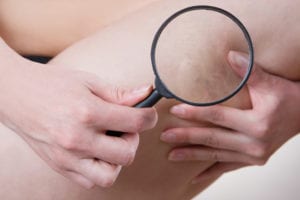VenaSeal Treatment
The VenaSeal treatment procedure involves inserting a small catheter up the diseased vein. A tiny amount of cyanoacrylate glue is then delivered through the catheter to glue the target vein closed. This is the only procedure that does not require patients to wear compression stockings afterward, and initial studies have shown this to be as effective as RFA! Patients can resume normal activity immediately after the procedure.
What Is NonThermal Vein Treatment?
Endovenous thermal ablations such as RFA and laser, which are the standard of care for treating superficial venous reflux, use heat to close nonfunctioning veins. Because of the heat generated by the laser or RF catheters, local anesthetic is needed. While local anesthetic is diluted so that it is not as painful, it still requires multiple needle pokes to inject the anesthetic. Non Tumescent, Non Thermal techniques such as VenaSeal only require the local anesthetic at the site of catheter insertion and are therefore truly “pain free” procedures.

What Does VenaSeal (Vein Glue) Do?
Cyanoacrylate based glues have been used in medicine for several decades. For example, most people probably know someone who has had a laceration glued as opposed to using stitches. Since the mid-90s, doctors have been using cyanoacrylate glue to close off arterial bleeds in the brain for emergent cases, such as ruptured cerebral aneurysms. If these glues can close off a high-pressure arterial bleed, then it would make sense that the same glues could be used to close down a nonfunctioning vein as veins are a low flow and low pressure system.
How Effective Is The VenaSeal Procedure?
Clinical studies have shown VenaSeal to be as effective as the Radiofrequency ablations, with 99% success rate at 3 months and a 97% success rate at 12 months.
During the procedure, the physician inserts a catheter into the diseased vein under ultrasound guidance and then tiny amounts of glue can be delivered through the catheter to seal the vein closed. The catheter is removed at the end of the procedure and a Band-Aid is placed over the puncture site. VenaSeal can be used to safely treat both legs in the same setting, as no local anesthetic is used and it is the only technique approved for use that does not require patients to wear compression stockings after the procedure. Patients can resume normal activity as soon as the procedure is complete. Side effects of VenaSeal are minor and infrequent. The most common side effect is phlebitis or inflammation of a vein.
VenaSeal is a great option for patients who don’t want to or are unable to wear compression stockings. It is the only ablation technique that is FDA approved for use without compression, While most insurances require a trial of compression prior to treatment, VenaSeal is the only treatment option where compression is not needed post-op. Finally, like the other non-tumescent, non-thermal techniques, VenaSeal is great for patients who are needle phobic.
Schedule a consultation today!
We proudly serve patients from Traverse City, Cadillac, Manistee, Big Rapids, Houghton Lake, Grayling, Sault Ste. Marie MI and surrounding areas with VenalSeal treatments. Call today for your consultation at (231) 936-2068 or complete a Contact Form here! You can also find directions to our Traverse City and Cadillac, MI offices by clicking here. We look forward to serving you!

